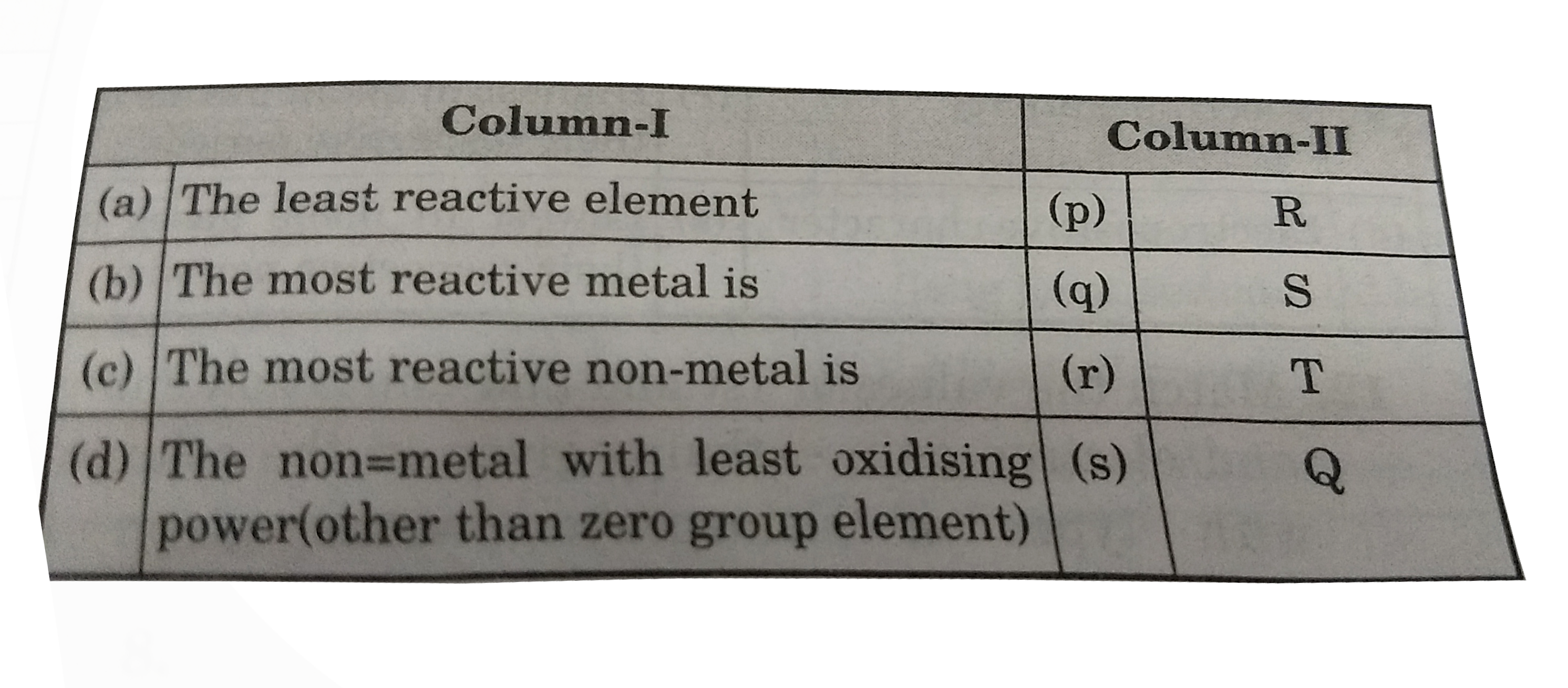The second electron gain enthalpies (in kJ mol−1) of oxygen and sulphur respectively are:
−780,+590
−590,+780
+590,+780
+780,+590
The correct Answer is:D
To determine the second electron gain enthalpies of oxygen and sulfur, we can follow these steps:
Step 1: Understand Electron Gain Enthalpy
- Electron gain enthalpy is the energy change when an atom gains an electron. For the first electron gain, energy is typically released (negative value). However, for the second electron gain, the situation changes.
Step 2: Analyze the First Electron Gain
- When oxygen (O) gains its first electron, it forms O⁻. This process releases energy, resulting in a negative electron gain enthalpy. The same applies to sulfur (S) when it gains its first electron to form S⁻.
Step 3: Consider the Second Electron Gain
- The second electron gain involves an anion (O⁻ or S⁻) gaining another electron. For O⁻ to gain another electron and become O²⁻, it must overcome the repulsion between the negatively charged O⁻ and the incoming electron. This requires energy, making the second electron gain enthalpy positive.
Step 4: Compare Oxygen and Sulfur
- Both O and S will have positive second electron gain enthalpies. However, we need to compare their values. As we move down the group in the periodic table, the atomic size increases, which generally decreases the tendency to gain electrons.
Step 5: Analyze the Size and Electron Repulsion
- Oxygen has a smaller atomic size compared to sulfur. The small size of oxygen leads to significant electron-electron repulsions in its 2p subshell when it tries to accommodate a second electron. This means that more energy is required for oxygen to gain a second electron compared to sulfur.
Step 6: Conclusion
- Therefore, the second electron gain enthalpy of oxygen is higher (more positive) than that of sulfur. The final values are:
- Second electron gain enthalpy of oxygen: approximately +144 kJ/mol
- Second electron gain enthalpy of sulfur: approximately +200 kJ/mol
Final Answer
The second electron gain enthalpies of oxygen and sulfur are approximately +144 kJ/mol and +200 kJ/mol, respectively.
---
- Electron gain enthalpy is the energy change when an atom gains an electron. For the first electron gain, energy is typically released (negative value). However, for the second electron gain, the situation changes.
- When oxygen (O) gains its first electron, it forms O⁻. This process releases energy, resulting in a negative electron gain enthalpy. The same applies to sulfur (S) when it gains its first electron to form S⁻.
- The second electron gain involves an anion (O⁻ or S⁻) gaining another electron. For O⁻ to gain another electron and become O²⁻, it must overcome the repulsion between the negatively charged O⁻ and the incoming electron. This requires energy, making the second electron gain enthalpy positive.
- Both O and S will have positive second electron gain enthalpies. However, we need to compare their values. As we move down the group in the periodic table, the atomic size increases, which generally decreases the tendency to gain electrons.
- Oxygen has a smaller atomic size compared to sulfur. The small size of oxygen leads to significant electron-electron repulsions in its 2p subshell when it tries to accommodate a second electron. This means that more energy is required for oxygen to gain a second electron compared to sulfur.
- Therefore, the second electron gain enthalpy of oxygen is higher (more positive) than that of sulfur. The final values are:
- Second electron gain enthalpy of oxygen: approximately +144 kJ/mol
- Second electron gain enthalpy of sulfur: approximately +200 kJ/mol
The second electron gain enthalpies of oxygen and sulfur are approximately +144 kJ/mol and +200 kJ/mol, respectively.
Topper's Solved these Questions
- PERIODIC PROPERTIESBOOK - VK JAISWAL ENGLISHCHAPTER - PERIODIC PROPERTIESEXERCISE - MATCH THE COLUMN
11 Videos
- PERIODIC PROPERTIESBOOK - VK JAISWAL ENGLISHCHAPTER - PERIODIC PROPERTIESEXERCISE - SUBJECTIVE PROBLEMS
22 Videos
- p-BLOCK ELEMENTSBOOK - VK JAISWAL ENGLISHCHAPTER - p-BLOCK ELEMENTSEXERCISE - SUBJECTIVE PROBLEMS
35 Videos
- QUALITATIVE INORGANIC ANALYSISBOOK - VK JAISWAL ENGLISHCHAPTER - QUALITATIVE INORGANIC ANALYSISEXERCISE - SUBJECTIVE PROBLEMS
4 Videos
Similar Questions
Electron Gain Enthalpy
View SolutionThe correct order of electron gain enthalpy (in kJ/mole) is
View SolutionThe electron gain enthalpy (in kJ/mole) of Oxygen, Sulphur,Selenium and Tellurium respectively are :
View SolutionThe electron gain enthalpy (in kJ/mole) of F, O, N and C respectively are :
View SolutionThe first (ΔH1) and second (ΔH2) ionisation enthalpies (in kJmol−1) and the (ΔHeg) electron gain enthalpy (in kJmol−1) of a elements are given below:

Based on the above information match the following columns.

View SolutionThe first (Δi,H1) and the second (Δ,H2) ionisation enthalpies (in kJ mol−1 ) and the (ΔegH) electron gain enthalpy (in kJ mol−1 ) of a few elements are given below :

Which of the above elements is likely to be :
a reactive metal
View SolutionThe electron gain enthalpy ( in kJ//mol ) of fluorine, chlorine, bromine and iodine, respectively ,are :
View SolutionElectron gain enthalpy will be positive in
View SolutionThe first (Δi,H1) and the second (Δ,H2) ionisation enthalpies (in kJ mol−1 ) and the (ΔegH) electron gain enthalpy (in kJ mol−1 ) of a few elements are given below :

Which of the above elements is likely to be :
the least reactive element?
View SolutionThe electron gain enthalpy of oxygen is …………………. than that of sulphur.
View Solution
